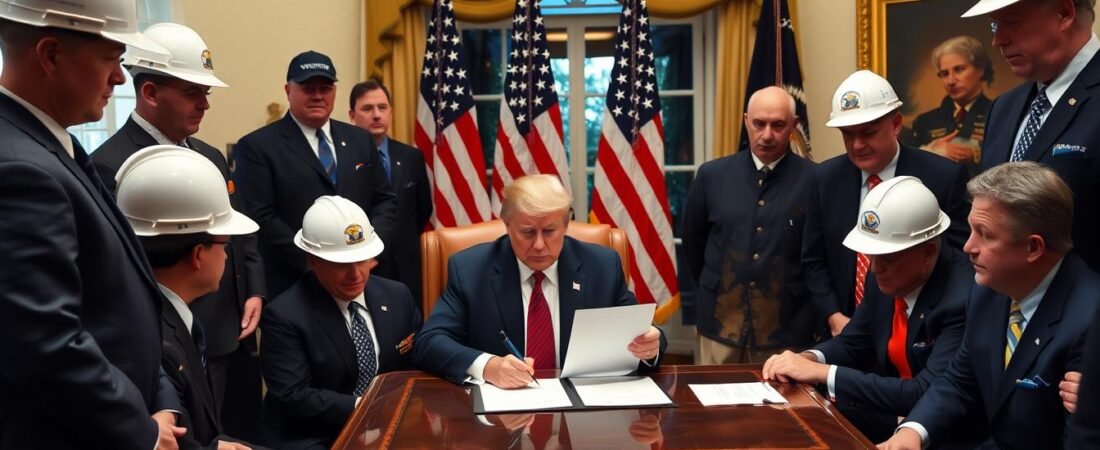President Donald Trump’s ambitious energy and infrastructure agenda has reignited the classic American debate between economic growth and environmental protection. His executive orders and budget proposals signal a dramatic shift in federal priorities, emphasizing fossil fuel development, nuclear energy expansion, and infrastructure investment while scaling back renewable energy initiatives and environmental regulations. This analysis examines the data behind Trump’s plans, comparing projected economic benefits against potential environmental costs.
Trump’s Energy Vision: Historical Context and New Directions
President Trump signs executive orders aimed at revitalizing American energy production
Trump’s energy policy represents a significant departure from his predecessors. During his first term (2017-2021), Trump withdrew from the Paris Climate Agreement, expanded oil and gas leasing on federal lands, and rolled back over 100 environmental regulations. His current proposals double down on this approach with even more ambitious goals.
The cornerstone of Trump’s energy strategy is what he calls “energy dominance” – maximizing domestic production of all forms of energy with particular emphasis on fossil fuels and nuclear power. This marks a stark contrast to the Biden administration’s Inflation Reduction Act, which directed nearly $370 billion toward clean energy initiatives.
According to White House documents, Trump’s plan calls for adding 300 gigawatts of new nuclear capacity by 2050, accelerating oil and gas production, and canceling over $15.2 billion in bipartisan Infrastructure Investment and Jobs Act funding previously allocated for renewable energy projects.
Nuclear Renaissance: Centerpiece of Trump’s Energy Strategy
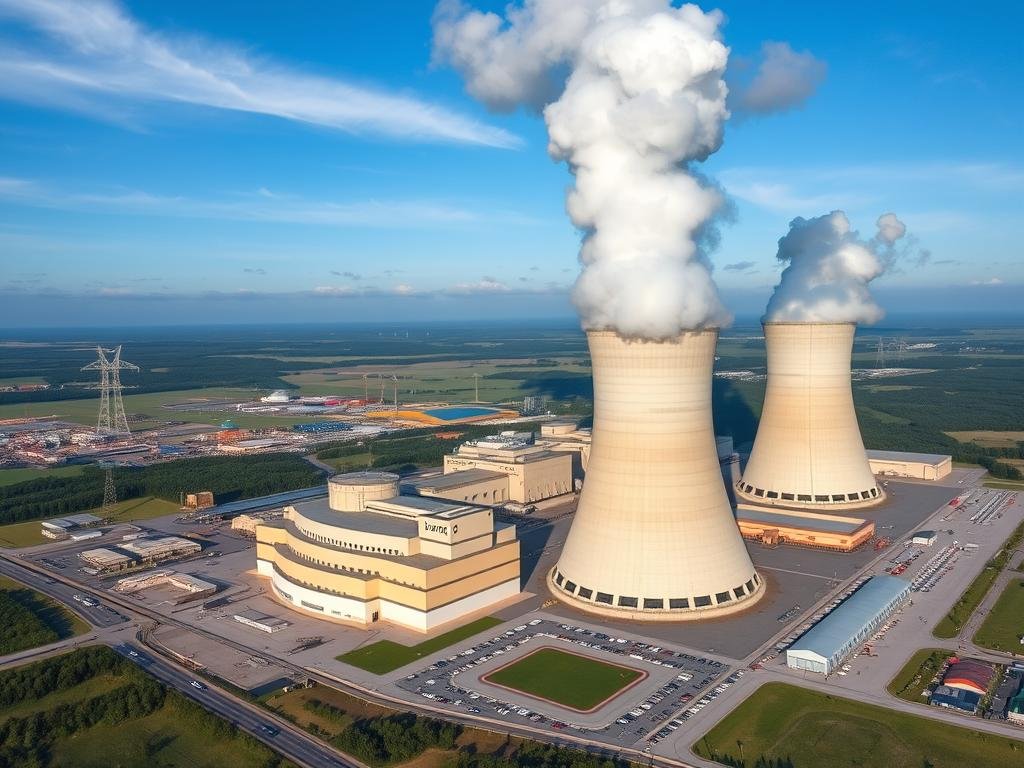
Nuclear energy forms a key component of Trump’s energy dominance agenda
Nuclear energy stands at the forefront of Trump’s energy strategy. His executive orders outline an aggressive expansion of America’s nuclear capacity from around 100 gigawatts today to 400 gigawatts by 2050. This plan includes:
- Expedited licensing pathways for new nuclear reactors
- Streamlined testing protocols for advanced reactor designs
- Deployment of nuclear reactors for national security applications
- Revitalization of the domestic nuclear supply chain
- Exploration of fuel recycling and reprocessing technologies
Dr. Michael Goff, Principal Deputy Assistant Secretary for the Department of Energy’s Office of Nuclear Energy, notes that “these executive orders will unshackle our civil nuclear potential and usher in an American nuclear energy renaissance, ensuring abundant, reliable, and affordable energy for the United States.”
The plan calls for completing 10 new large reactor designs and beginning construction by 2030, with three pilot reactors achieving criticality by July 4, 2026. The administration also aims to facilitate 5 gigawatts of power uprates at existing plants and support the restart of recently decommissioned facilities like the Palisades plant in Michigan.
Stay Informed on Nuclear Policy Developments
Get expert analysis on how nuclear expansion could affect energy markets, jobs, and environmental goals.
Fossil Fuel Resurgence: Oil, Gas, and Coal Priorities
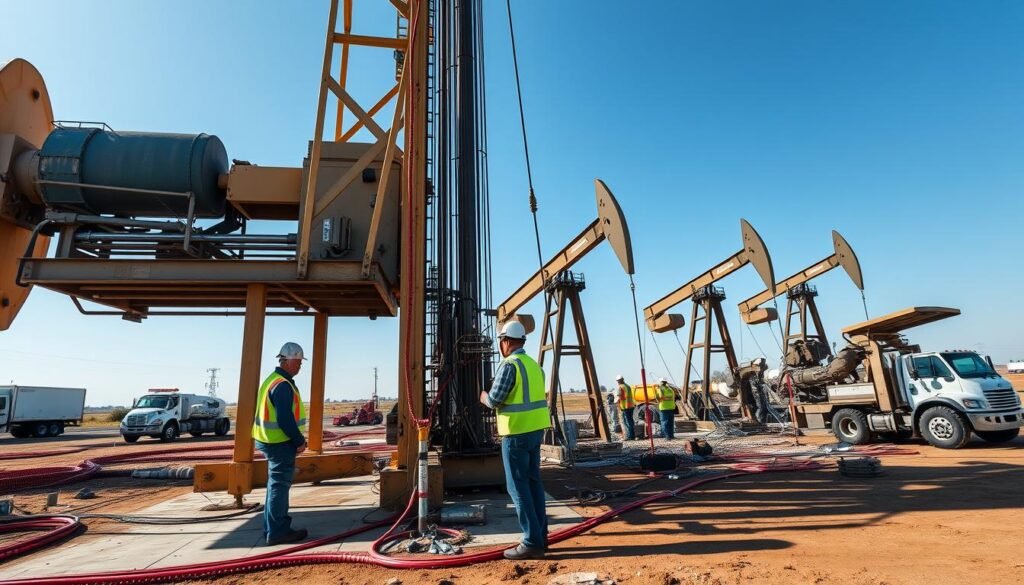
Trump’s plan emphasizes expanded domestic oil and gas production
Trump’s energy agenda places significant emphasis on expanding fossil fuel production. His administration has already halted permitting for renewable energy projects while prioritizing oil and gas development. Key elements include:
Oil and Gas Expansion
The plan calls for increased drilling on federal lands and waters, with the Bureau of Land Management directed to expedite leasing and permitting processes. Offshore oil development is prioritized over offshore wind, with Trump’s executive order halting new offshore wind leases while encouraging oil exploration.
According to industry projections, this approach could increase domestic oil production by up to 2 million barrels per day by 2028, potentially creating 350,000 direct jobs in extraction, refining, and related services.
Coal Industry Support
Despite market challenges facing coal, Trump’s plan includes measures to revitalize the industry through regulatory relief and infrastructure support. The administration has eliminated the Office of Energy Efficiency and Renewable Energy’s coal plant conversion programs.
Mark Zandi, chief economist at Moody’s Analytics, notes that “while these policies may temporarily boost coal employment in certain regions, long-term market forces continue to favor natural gas and renewables on pure cost considerations.”
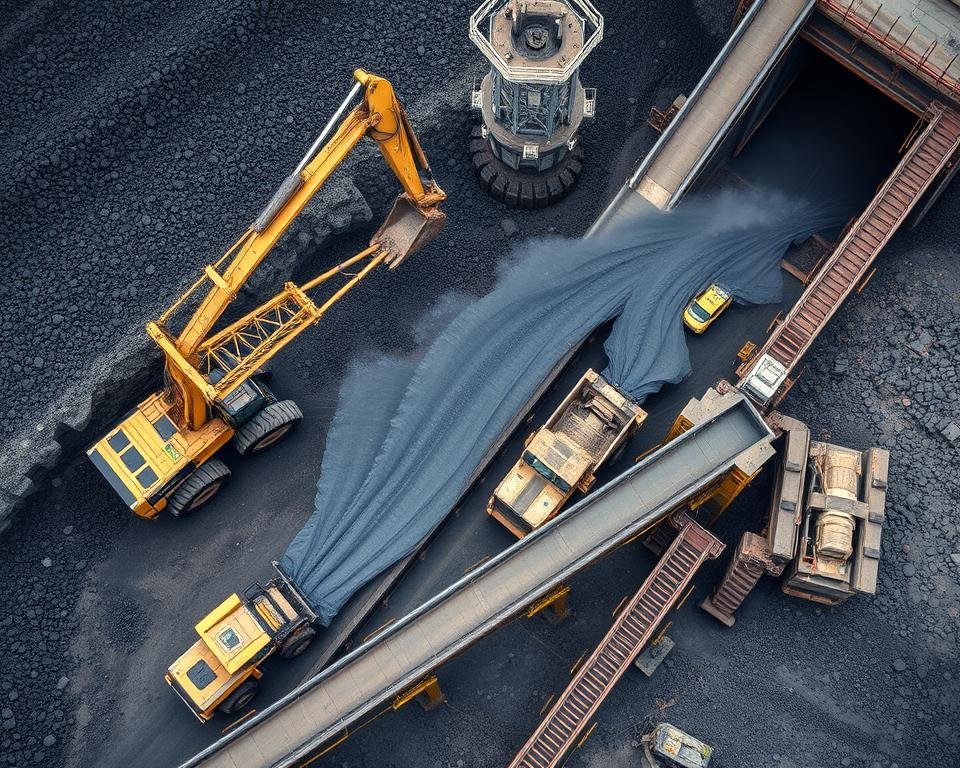
Coal industry revitalization efforts face significant market headwinds
Renewable Energy Rollbacks: Funding Cuts and Regulatory Changes
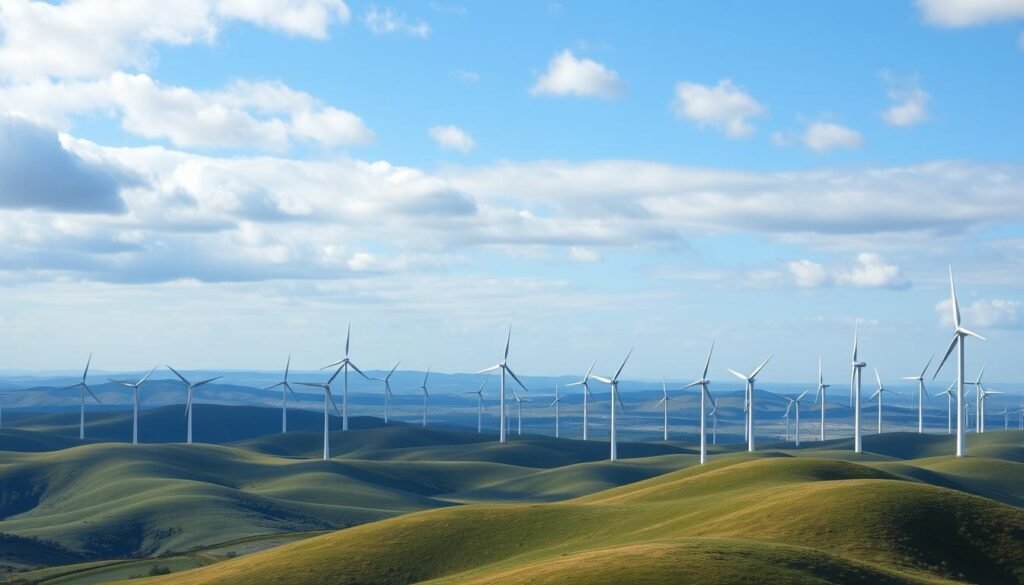
Wind energy projects face significant federal obstacles under Trump’s policies
Trump’s energy plan includes substantial reductions in federal support for renewable energy. His budget proposal cuts $2.5 billion from the Department of Energy’s Energy Efficiency and Renewable Energy program, characterizing it as advancing “the destructive Green New Deal agenda.”
The administration has frozen grants and loans supporting rooftop solar, household weatherization, and electric vehicle charging infrastructure. Additionally, Trump has halted permitting for 168 renewable energy projects on private lands through the Army Corps of Engineers.
“These actions are sowing a lot of chaos. The longer that goes on, the more likely projects go away. If developers start pulling back from large projects, those are big parts of meeting clean energy goals for a lot of these states.”
The Rhodium Group projects these policy changes could lead to a 20% rise in U.S. emissions by 2030 compared to the trajectory under the Biden administration’s policies. However, market forces continue to favor renewable expansion in many regions due to falling costs.
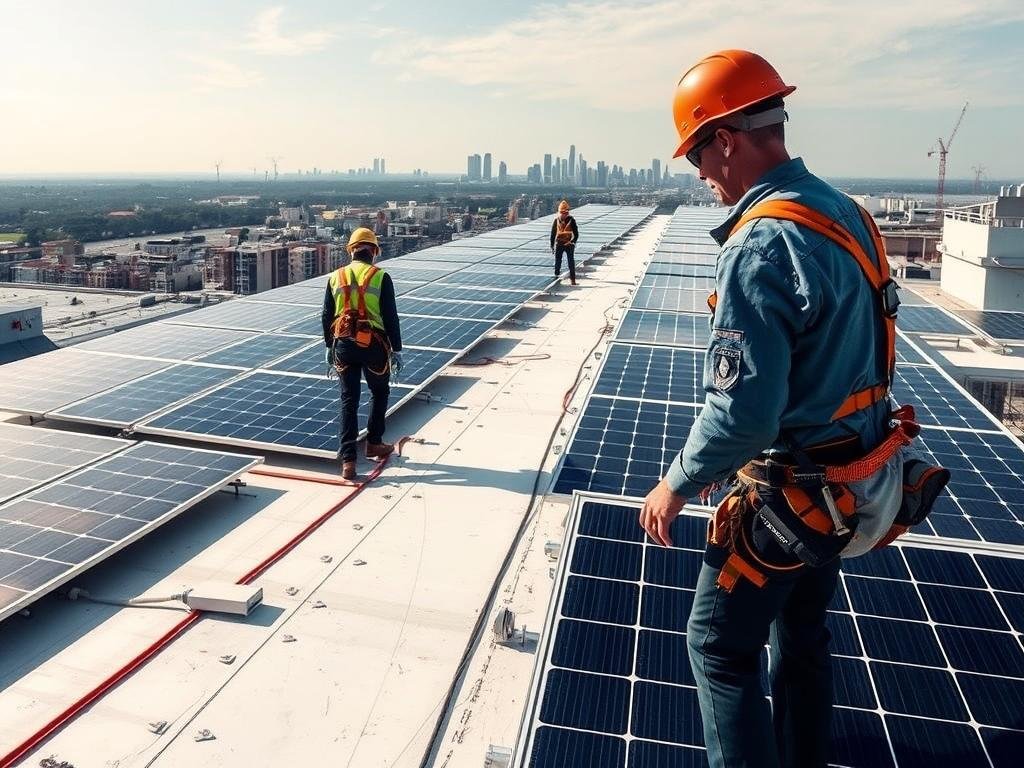
Commercial solar installations may continue despite federal policy shifts
Infrastructure Investment: Roads, Bridges, and Energy Systems

Infrastructure development remains a priority despite environmental rollbacks
Despite cuts to renewable energy programs, Trump’s “Big Beautiful Bill” includes significant infrastructure investments focused on traditional transportation and energy systems. The plan proposes:
Transportation Infrastructure
- $200 billion for highway expansion and modernization
- $50 billion for bridge repair and replacement
- $25 billion for airport improvements
- $30 billion for port and waterway development
Energy Infrastructure
- $40 billion for electrical grid hardening and expansion
- $35 billion for natural gas pipeline development
- $20 billion for nuclear facility modernization
- $15 billion for petroleum reserve and storage systems
The Congressional Budget Office estimates these investments could create approximately 1.2 million construction and manufacturing jobs over a five-year period. However, critics note that the plan lacks specific funding mechanisms and relies heavily on private investment incentives rather than direct federal spending.
Dr. Leah Stokes, Associate Professor of Environmental Politics at UC Santa Barbara, observes that “the infrastructure plan prioritizes 20th-century systems over the grid modernization needed for 21st-century energy challenges, particularly the growing demands from AI and data centers.”
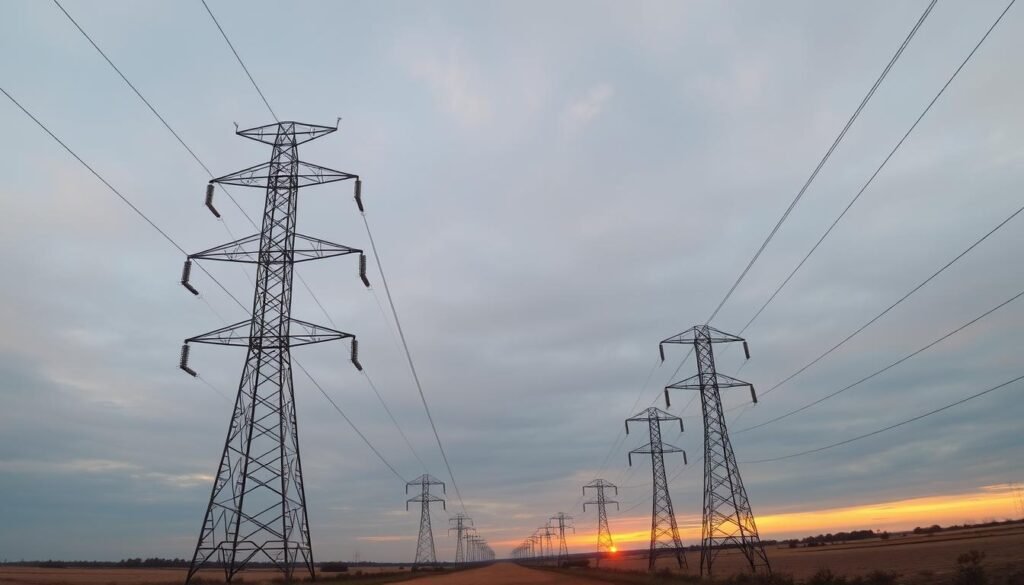
Grid expansion focuses on traditional infrastructure rather than smart grid technologies
The Jobs vs. Environment Debate: Analyzing the Trade-offs
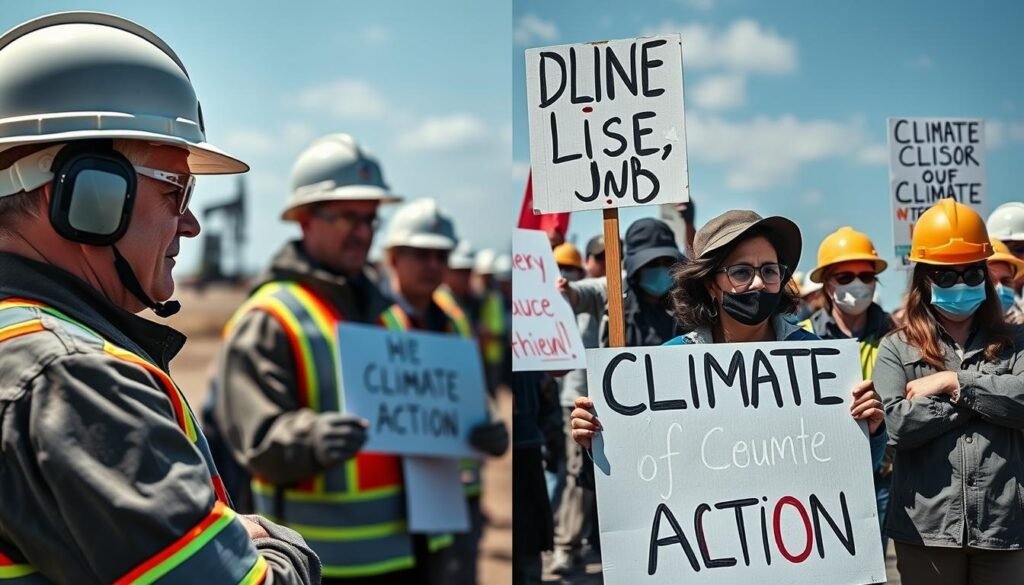
Trump’s energy policies highlight the tension between economic and environmental priorities
Economic Benefits
- Potential creation of 2 million energy sector jobs according to administration projections
- Reduced energy costs for manufacturers and consumers
- Increased domestic energy production and reduced imports
- Infrastructure investment stimulating construction and manufacturing
- Nuclear industry revitalization creating high-skilled technical positions
Environmental Concerns
- Projected 20% increase in carbon emissions by 2030 (Rhodium Group)
- Potential loss of 500,000 clean energy jobs (Princeton University study)
- Increased air and water pollution from fossil fuel expansion
- Reduced federal environmental oversight and enforcement
- Potential long-term economic costs from climate change impacts
The debate over Trump’s energy and infrastructure plans fundamentally centers on differing priorities and timeframes. Supporters emphasize immediate job creation and energy affordability, while critics focus on long-term environmental sustainability and climate impacts.
Congressional reactions have fallen along partisan lines. House Speaker Mike Johnson (R-LA) praised the plan, stating it “ensures every federal taxpayer dollar spent is used to serve the American people, not a bloated bureaucracy or partisan pet projects.” Meanwhile, Senator Patty Murray (D-WA) criticized the approach, arguing it “defunds programs that help working Americans while shoveling massive tax breaks at billionaires.”
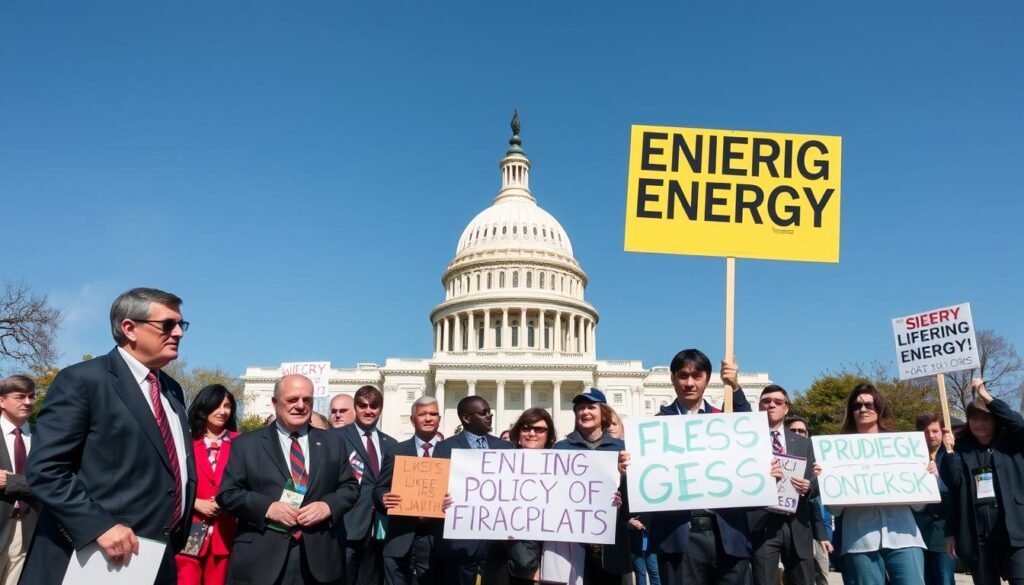
Congressional debate reflects broader national divisions on energy priorities
State-Level Responses: Adaptation and Resistance

States are pursuing divergent energy strategies in response to federal policy shifts
As federal priorities shift, states are developing varied responses to Trump’s energy agenda. Blue states are working to maintain their clean energy transitions despite federal headwinds, while red states are embracing expanded fossil fuel development.
Blue State Strategies
States like California, New York, and Massachusetts are doubling down on state-level clean energy investments and regulations. New York state Senator Kevin Parker notes, “We’re going to challenge every illegal and out-of-order action by this administration and continue to work towards our goals.”
These states are exploring financing mechanisms that reduce dependence on federal support, including green banks, state tax incentives, and public-private partnerships.
Red State Approaches
Energy-producing states like Texas, Oklahoma, and Wyoming are embracing Trump’s fossil fuel expansion while also maintaining existing renewable investments. Texas Governor Greg Abbott has highlighted his state’s nation-leading wind production while also promoting natural gas development.
These states are focusing on balancing traditional energy production with market-driven renewable growth, particularly where economics favor wind and solar.
Purple State Balancing
Swing states like Michigan, Pennsylvania, and Wisconsin are navigating competing interests between traditional energy jobs and growing clean energy sectors. These states are developing hybrid approaches that support both fossil fuel workers and renewable development.
Minnesota state Senator Nick Frentz observes, “I’m fairly confident that affordability and reliability will continue to drive clean energy into Minnesota’s energy mix” despite federal policy changes.
Conclusion: Navigating America’s Energy Future
Trump’s energy and infrastructure plans represent a significant pivot in federal policy, prioritizing fossil fuel development, nuclear expansion, and traditional infrastructure while reducing support for renewable energy and environmental programs. The administration frames these changes as necessary to ensure energy affordability, reliability, and American energy dominance.
The debate ultimately reflects different visions of America’s energy future – one emphasizing immediate economic benefits and traditional energy systems, the other focused on long-term sustainability and climate considerations. As federal policies evolve, states, businesses, and consumers will continue adapting their own strategies based on regional priorities, market forces, and environmental concerns.
What remains clear is that energy policy will continue to be a central battleground in American politics, with significant implications for jobs, the environment, and the nation’s economic competitiveness in a rapidly changing global energy landscape.
Get Our Comprehensive Analysis Report
Download our detailed data-driven report on Trump’s Energy and Infrastructure Plans, including economic projections, environmental impact assessments, and state-by-state analysis.
